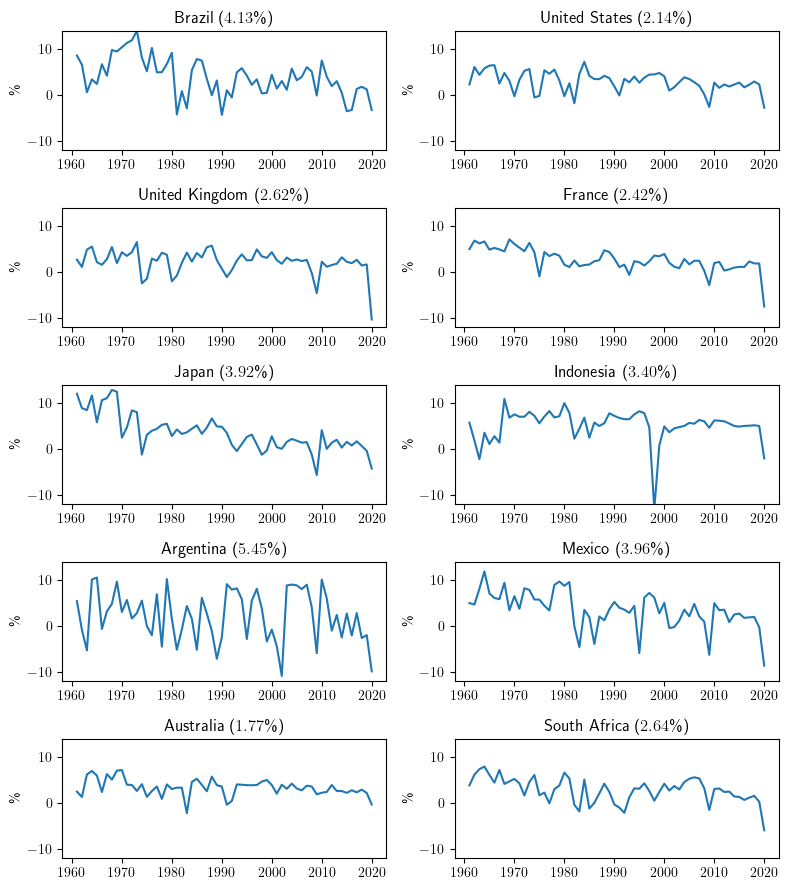Chapter 2 - Production (Python Code)#
! pip install --upgrade quantecon_book_networks
Show code cell output
Requirement already satisfied: quantecon_book_networks in /usr/share/miniconda3/envs/networks/lib/python3.11/site-packages (1.1)
Requirement already satisfied: numpy in /usr/share/miniconda3/envs/networks/lib/python3.11/site-packages (from quantecon_book_networks) (1.24.3)
Requirement already satisfied: scipy in /usr/share/miniconda3/envs/networks/lib/python3.11/site-packages (from quantecon_book_networks) (1.11.1)
Requirement already satisfied: pandas in /usr/share/miniconda3/envs/networks/lib/python3.11/site-packages (from quantecon_book_networks) (2.0.3)
Requirement already satisfied: matplotlib in /usr/share/miniconda3/envs/networks/lib/python3.11/site-packages (from quantecon_book_networks) (3.7.2)
Requirement already satisfied: pandas-datareader in /usr/share/miniconda3/envs/networks/lib/python3.11/site-packages (from quantecon_book_networks) (0.10.0)
Requirement already satisfied: networkx in /usr/share/miniconda3/envs/networks/lib/python3.11/site-packages (from quantecon_book_networks) (3.1)
Requirement already satisfied: quantecon in /usr/share/miniconda3/envs/networks/lib/python3.11/site-packages (from quantecon_book_networks) (0.7.1)
Requirement already satisfied: POT in /usr/share/miniconda3/envs/networks/lib/python3.11/site-packages (from quantecon_book_networks) (0.9.3)
Requirement already satisfied: contourpy>=1.0.1 in /usr/share/miniconda3/envs/networks/lib/python3.11/site-packages (from matplotlib->quantecon_book_networks) (1.0.5)
Requirement already satisfied: cycler>=0.10 in /usr/share/miniconda3/envs/networks/lib/python3.11/site-packages (from matplotlib->quantecon_book_networks) (0.11.0)
Requirement already satisfied: fonttools>=4.22.0 in /usr/share/miniconda3/envs/networks/lib/python3.11/site-packages (from matplotlib->quantecon_book_networks) (4.25.0)
Requirement already satisfied: kiwisolver>=1.0.1 in /usr/share/miniconda3/envs/networks/lib/python3.11/site-packages (from matplotlib->quantecon_book_networks) (1.4.4)
Requirement already satisfied: packaging>=20.0 in /usr/share/miniconda3/envs/networks/lib/python3.11/site-packages (from matplotlib->quantecon_book_networks) (23.1)
Requirement already satisfied: pillow>=6.2.0 in /usr/share/miniconda3/envs/networks/lib/python3.11/site-packages (from matplotlib->quantecon_book_networks) (9.4.0)
Requirement already satisfied: pyparsing<3.1,>=2.3.1 in /usr/share/miniconda3/envs/networks/lib/python3.11/site-packages (from matplotlib->quantecon_book_networks) (3.0.9)
Requirement already satisfied: python-dateutil>=2.7 in /usr/share/miniconda3/envs/networks/lib/python3.11/site-packages (from matplotlib->quantecon_book_networks) (2.8.2)
Requirement already satisfied: pytz>=2020.1 in /usr/share/miniconda3/envs/networks/lib/python3.11/site-packages (from pandas->quantecon_book_networks) (2023.3.post1)
Requirement already satisfied: tzdata>=2022.1 in /usr/share/miniconda3/envs/networks/lib/python3.11/site-packages (from pandas->quantecon_book_networks) (2023.3)
Requirement already satisfied: lxml in /usr/share/miniconda3/envs/networks/lib/python3.11/site-packages (from pandas-datareader->quantecon_book_networks) (4.9.3)
Requirement already satisfied: requests>=2.19.0 in /usr/share/miniconda3/envs/networks/lib/python3.11/site-packages (from pandas-datareader->quantecon_book_networks) (2.31.0)
Requirement already satisfied: numba>=0.49.0 in /usr/share/miniconda3/envs/networks/lib/python3.11/site-packages (from quantecon->quantecon_book_networks) (0.57.1)
Requirement already satisfied: sympy in /usr/share/miniconda3/envs/networks/lib/python3.11/site-packages (from quantecon->quantecon_book_networks) (1.11.1)
Requirement already satisfied: llvmlite<0.41,>=0.40.0dev0 in /usr/share/miniconda3/envs/networks/lib/python3.11/site-packages (from numba>=0.49.0->quantecon->quantecon_book_networks) (0.40.0)
Requirement already satisfied: six>=1.5 in /usr/share/miniconda3/envs/networks/lib/python3.11/site-packages (from python-dateutil>=2.7->matplotlib->quantecon_book_networks) (1.16.0)
Requirement already satisfied: charset-normalizer<4,>=2 in /usr/share/miniconda3/envs/networks/lib/python3.11/site-packages (from requests>=2.19.0->pandas-datareader->quantecon_book_networks) (2.0.4)
Requirement already satisfied: idna<4,>=2.5 in /usr/share/miniconda3/envs/networks/lib/python3.11/site-packages (from requests>=2.19.0->pandas-datareader->quantecon_book_networks) (3.4)
Requirement already satisfied: urllib3<3,>=1.21.1 in /usr/share/miniconda3/envs/networks/lib/python3.11/site-packages (from requests>=2.19.0->pandas-datareader->quantecon_book_networks) (1.26.16)
Requirement already satisfied: certifi>=2017.4.17 in /usr/share/miniconda3/envs/networks/lib/python3.11/site-packages (from requests>=2.19.0->pandas-datareader->quantecon_book_networks) (2023.7.22)
Requirement already satisfied: mpmath>=0.19 in /usr/share/miniconda3/envs/networks/lib/python3.11/site-packages (from sympy->quantecon->quantecon_book_networks) (1.3.0)
We begin with some imports.
import quantecon as qe
import quantecon_book_networks
import quantecon_book_networks.input_output as qbn_io
import quantecon_book_networks.plotting as qbn_plt
import quantecon_book_networks.data as qbn_data
ch2_data = qbn_data.production()
default_figsize = (6, 4)
export_figures = False
import numpy as np
import pandas as pd
import networkx as nx
import matplotlib.pyplot as plt
import matplotlib.cm as cm
import matplotlib.colors as plc
from matplotlib import cm
quantecon_book_networks.config("matplotlib")
Multisector Models#
We start by loading a graph of linkages between 15 US sectors in 2021.
Our graph comes as a list of sector codes, an adjacency matrix of sales between the sectors, and a list the total sales of each sector.
In particular, Z[i,j] is the sales from industry i to industry j, and X[i] is the the total sales
of each sector i.
codes = ch2_data["us_sectors_15"]["codes"]
Z = ch2_data["us_sectors_15"]["adjacency_matrix"]
X = ch2_data["us_sectors_15"]["total_industry_sales"]
Now we define a function to build coefficient matrices.
Two coefficient matrices are returned. The backward linkage case, where sales
between sector i and j are given as a fraction of total sales of sector
j. The forward linkage case, where sales between sector i and j are
given as a fraction of total sales of sector i.
def build_coefficient_matrices(Z, X):
"""
Build coefficient matrices A and F from Z and X via
A[i, j] = Z[i, j] / X[j]
F[i, j] = Z[i, j] / X[i]
"""
A, F = np.empty_like(Z), np.empty_like(Z)
n = A.shape[0]
for i in range(n):
for j in range(n):
A[i, j] = Z[i, j] / X[j]
F[i, j] = Z[i, j] / X[i]
return A, F
A, F = build_coefficient_matrices(Z, X)
Backward linkages for 15 US sectors in 2021#
Here we calculate the hub-based eigenvector centrality of our backward linkage coefficient matrix.
centrality = qbn_io.eigenvector_centrality(A)
Now we use the quantecon_book_networks package to produce our plot.
fig, ax = plt.subplots(figsize=(8, 10))
plt.axis("off")
color_list = qbn_io.colorise_weights(centrality, beta=False)
# Remove self-loops
A1 = A.copy()
for i in range(A1.shape[0]):
A1[i][i] = 0
qbn_plt.plot_graph(A1, X, ax, codes,
layout_type='spring',
layout_seed=5432167,
tol=0.0,
node_color_list=color_list)
if export_figures:
plt.savefig("figures/input_output_analysis_15.pdf")
plt.show()
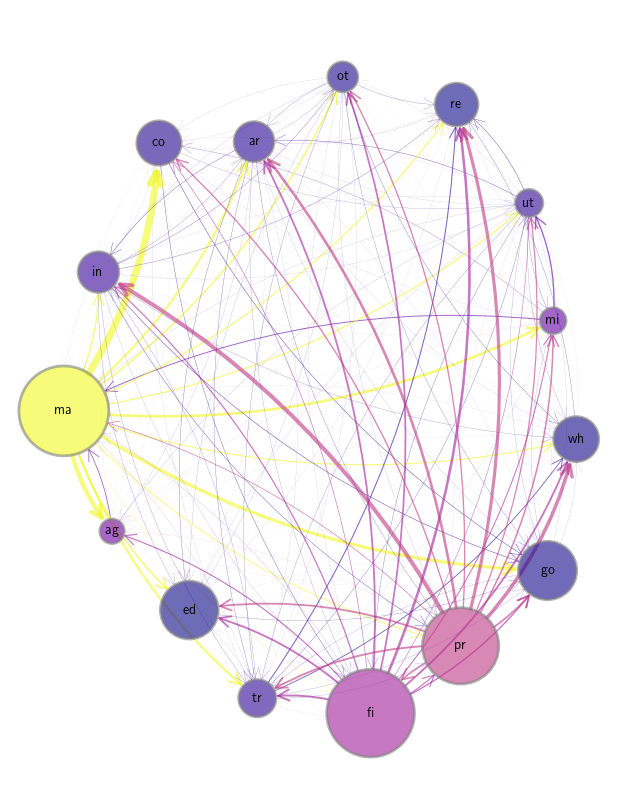
Eigenvector centrality of across US industrial sectors#
Now we plot a bar chart of hub-based eigenvector centrality by sector.
fig, ax = plt.subplots(figsize=default_figsize)
ax.bar(codes, centrality, color=color_list, alpha=0.6)
ax.set_ylabel("eigenvector centrality", fontsize=12)
if export_figures:
plt.savefig("figures/input_output_analysis_15_ec.pdf")
plt.show()
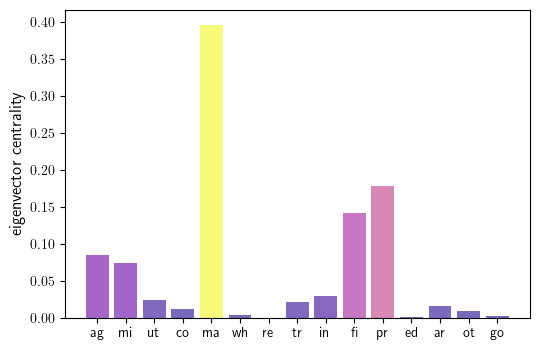
Output multipliers across 15 US industrial sectors#
Output multipliers are equal to the authority-based Katz centrality measure of the backward linkage coefficient matrix.
Here we calculate authority-based
Katz centrality using the quantecon_book_networks package.
omult = qbn_io.katz_centrality(A, authority=True)
fig, ax = plt.subplots(figsize=default_figsize)
omult_color_list = qbn_io.colorise_weights(omult,beta=False)
ax.bar(codes, omult, color=omult_color_list, alpha=0.6)
ax.set_ylabel("Output multipliers", fontsize=12)
if export_figures:
plt.savefig("figures/input_output_analysis_15_omult.pdf")
plt.show()
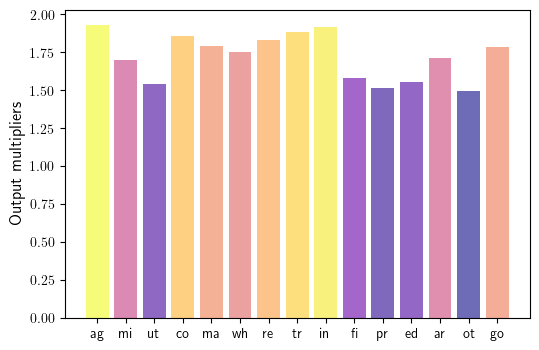
Forward linkages and upstreamness over US industrial sectors#
Upstreamness is the hub-based Katz centrality of the forward linkage coefficient matrix.
Here we calculate hub-based Katz centrality.
upstreamness = qbn_io.katz_centrality(F)
Now we plot the network.
fig, ax = plt.subplots(figsize=(8, 10))
plt.axis("off")
upstreamness_color_list = qbn_io.colorise_weights(upstreamness,beta=False)
# Remove self-loops
for i in range(F.shape[0]):
F[i][i] = 0
qbn_plt.plot_graph(F, X, ax, codes,
layout_type='spring', # alternative layouts: spring, circular, random, spiral
layout_seed=5432167,
tol=0.0,
node_color_list=upstreamness_color_list)
if export_figures:
plt.savefig("figures/input_output_analysis_15_fwd.pdf")
plt.show()
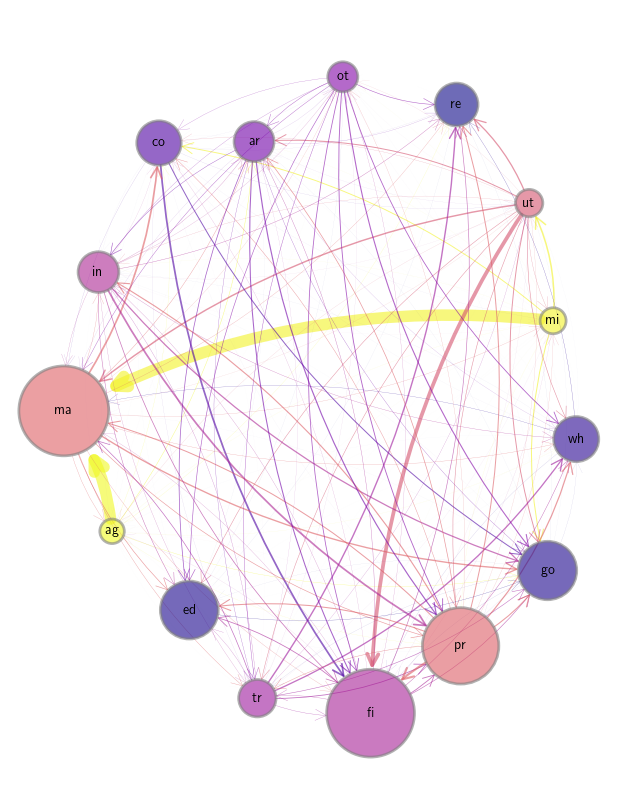
Relative upstreamness of US industrial sectors#
Here we produce a barplot of upstreamness.
fig, ax = plt.subplots(figsize=default_figsize)
ax.bar(codes, upstreamness, color=upstreamness_color_list, alpha=0.6)
ax.set_ylabel("upstreamness", fontsize=12)
if export_figures:
plt.savefig("figures/input_output_analysis_15_up.pdf")
plt.show()
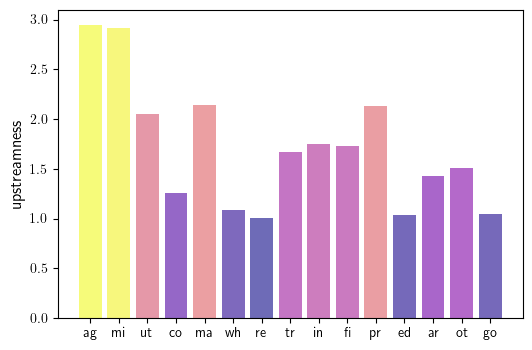
Hub-based Katz centrality of across 15 US industrial sectors#
Next we plot the hub-based Katz centrality of the backward linkage coefficient matrix.
kcentral = qbn_io.katz_centrality(A)
fig, ax = plt.subplots(figsize=default_figsize)
kcentral_color_list = qbn_io.colorise_weights(kcentral,beta=False)
ax.bar(codes, kcentral, color=kcentral_color_list, alpha=0.6)
ax.set_ylabel("Katz hub centrality", fontsize=12)
if export_figures:
plt.savefig("figures/input_output_analysis_15_katz.pdf")
plt.show()
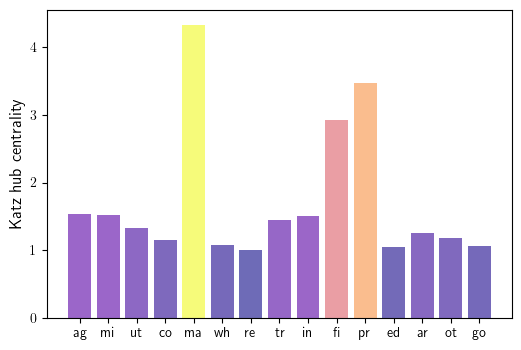
The Leontief inverse 𝐿 (hot colors are larger values)#
We construct the Leontief inverse matrix from 15 sector adjacency matrix.
I = np.identity(len(A))
L = np.linalg.inv(I - A)
Now we produce the plot.
fig, ax = plt.subplots(figsize=(6.5, 5.5))
ticks = range(len(L))
levels = np.sqrt(np.linspace(0, 0.75, 100))
co = ax.contourf(ticks,
ticks,
L,
levels,
alpha=0.85, cmap=cm.plasma)
ax.set_xlabel('sector $j$', fontsize=12)
ax.set_ylabel('sector $i$', fontsize=12)
ax.set_yticks(ticks)
ax.set_yticklabels(codes)
ax.set_xticks(ticks)
ax.set_xticklabels(codes)
if export_figures:
plt.savefig("figures/input_output_analysis_15_leo.pdf")
plt.show()
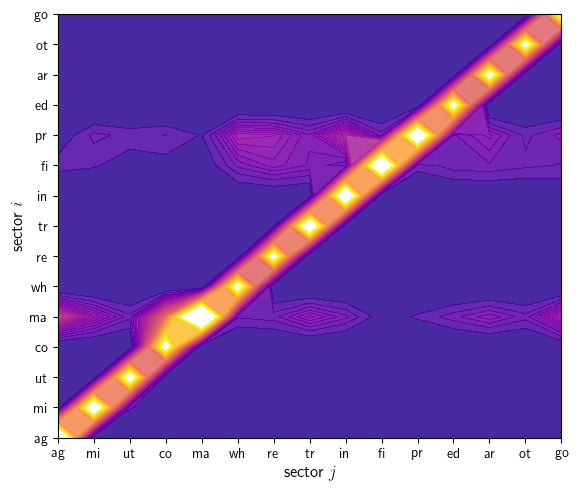
Propagation of demand shocks via backward linkages#
We begin by generating a demand shock vector \(d\).
N = len(A)
np.random.seed(1234)
d = np.random.rand(N)
d[6] = 1 # positive shock to agriculture
Now we simulate the demand shock propagating through the economy.
sim_length = 11
x = d
x_vecs = []
for i in range(sim_length):
if i % 2 ==0:
x_vecs.append(x)
x = A @ x
Finally, we plot the shock propagating through the economy.
fig, axes = plt.subplots(3, 2, figsize=(8, 10))
axes = axes.flatten()
for ax, x_vec, i in zip(axes, x_vecs, range(sim_length)):
if i % 2 != 0:
pass
ax.set_title(f"round {i*2}")
x_vec_cols = qbn_io.colorise_weights(x_vec,beta=False)
# remove self-loops
for i in range(len(A)):
A[i][i] = 0
qbn_plt.plot_graph(A, X, ax, codes,
layout_type='spring',
layout_seed=342156,
node_color_list=x_vec_cols,
node_size_multiple=0.00028,
edge_size_multiple=0.8)
plt.tight_layout()
if export_figures:
plt.savefig("figures/input_output_analysis_15_shocks.pdf")
plt.show()
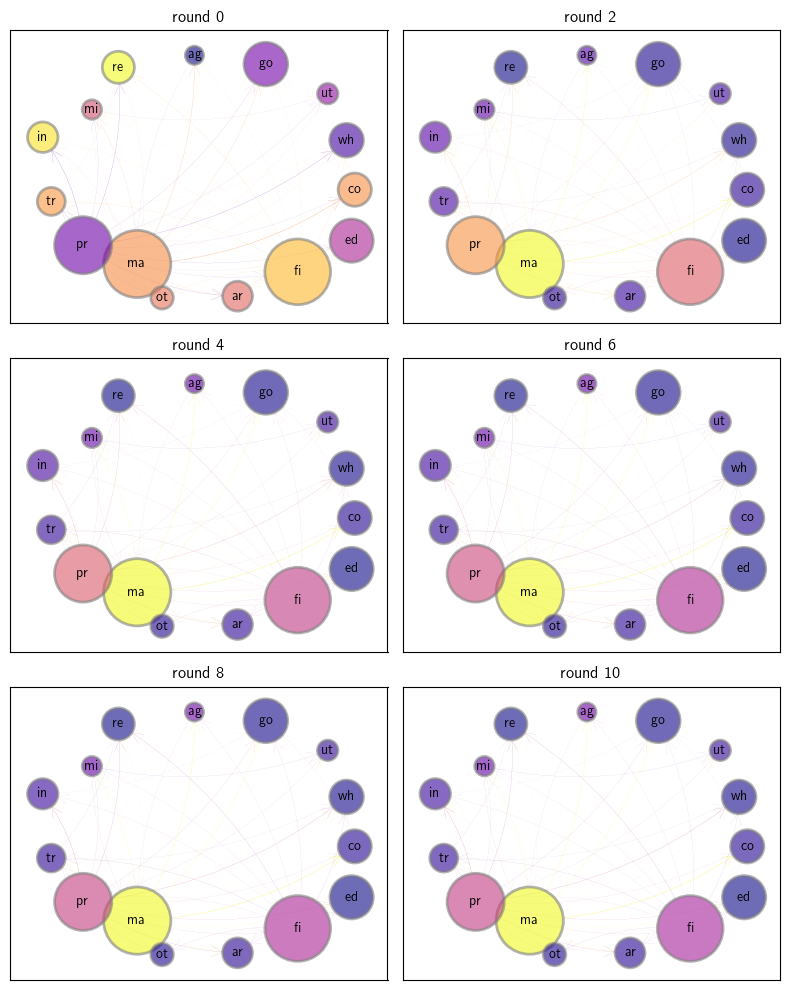
Network for 71 US sectors in 2021#
We start by loading a graph of linkages between 71 US sectors in 2021.
codes_71 = ch2_data['us_sectors_71']['codes']
A_71 = ch2_data['us_sectors_71']['adjacency_matrix']
X_71 = ch2_data['us_sectors_71']['total_industry_sales']
Next we calculate our graph’s properties.
We use hub-based eigenvector centrality as our centrality measure for this plot.
centrality_71 = qbn_io.eigenvector_centrality(A_71)
color_list_71 = qbn_io.colorise_weights(centrality_71,beta=False)
Finally we produce the plot.
fig, ax = plt.subplots(figsize=(10, 12))
plt.axis("off")
# Remove self-loops
for i in range(A_71.shape[0]):
A_71[i][i] = 0
qbn_plt.plot_graph(A_71, X_71, ax, codes_71,
node_size_multiple=0.0005,
edge_size_multiple=4.0,
layout_type='spring',
layout_seed=5432167,
tol=0.01,
node_color_list=color_list_71)
if export_figures:
plt.savefig("figures/input_output_analysis_71.pdf")
plt.show()
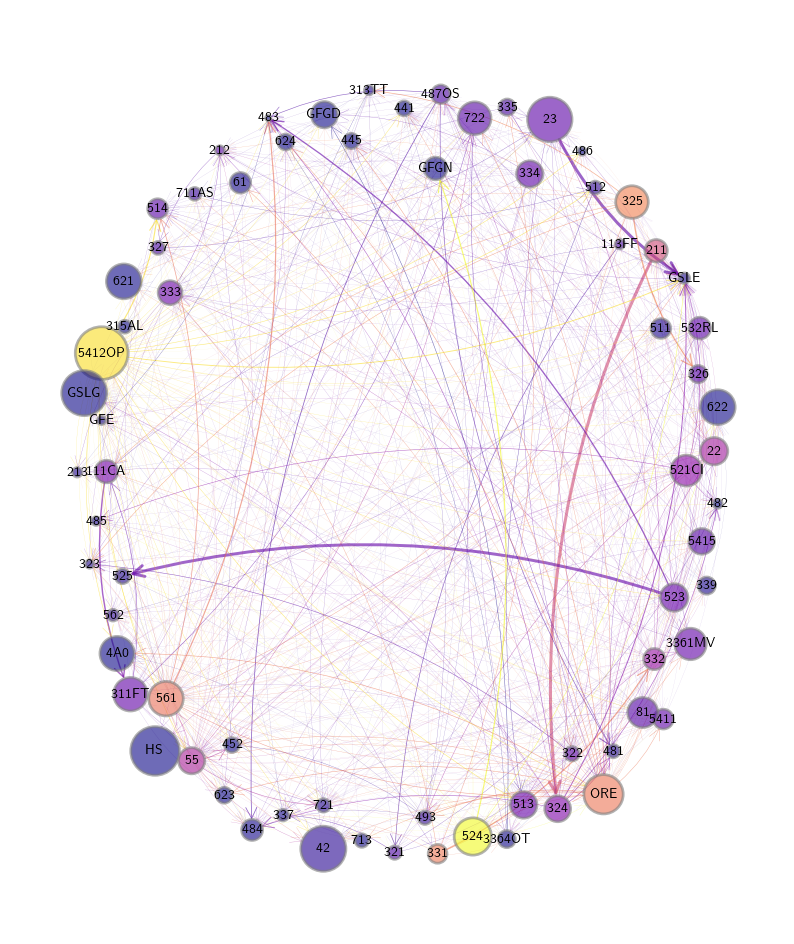
Network for 114 Australian industry sectors in 2020#
Next we load a graph of linkages between 114 Australian sectors in 2020.
codes_114 = ch2_data['au_sectors_114']['codes']
A_114 = ch2_data['au_sectors_114']['adjacency_matrix']
X_114 = ch2_data['au_sectors_114']['total_industry_sales']
Next we calculate our graph’s properties.
We use hub-based eigenvector centrality as our centrality measure for this plot.
centrality_114 = qbn_io.eigenvector_centrality(A_114)
color_list_114 = qbn_io.colorise_weights(centrality_114,beta=False)
Finally we produce the plot.
fig, ax = plt.subplots(figsize=(11, 13.2))
plt.axis("off")
# Remove self-loops
for i in range(A_114.shape[0]):
A_114[i][i] = 0
qbn_plt.plot_graph(A_114, X_114, ax, codes_114,
node_size_multiple=0.008,
edge_size_multiple=5.0,
layout_type='spring',
layout_seed=5432167,
tol=0.03,
node_color_list=color_list_114)
if export_figures:
plt.savefig("figures/input_output_analysis_aus_114.pdf")
plt.show()
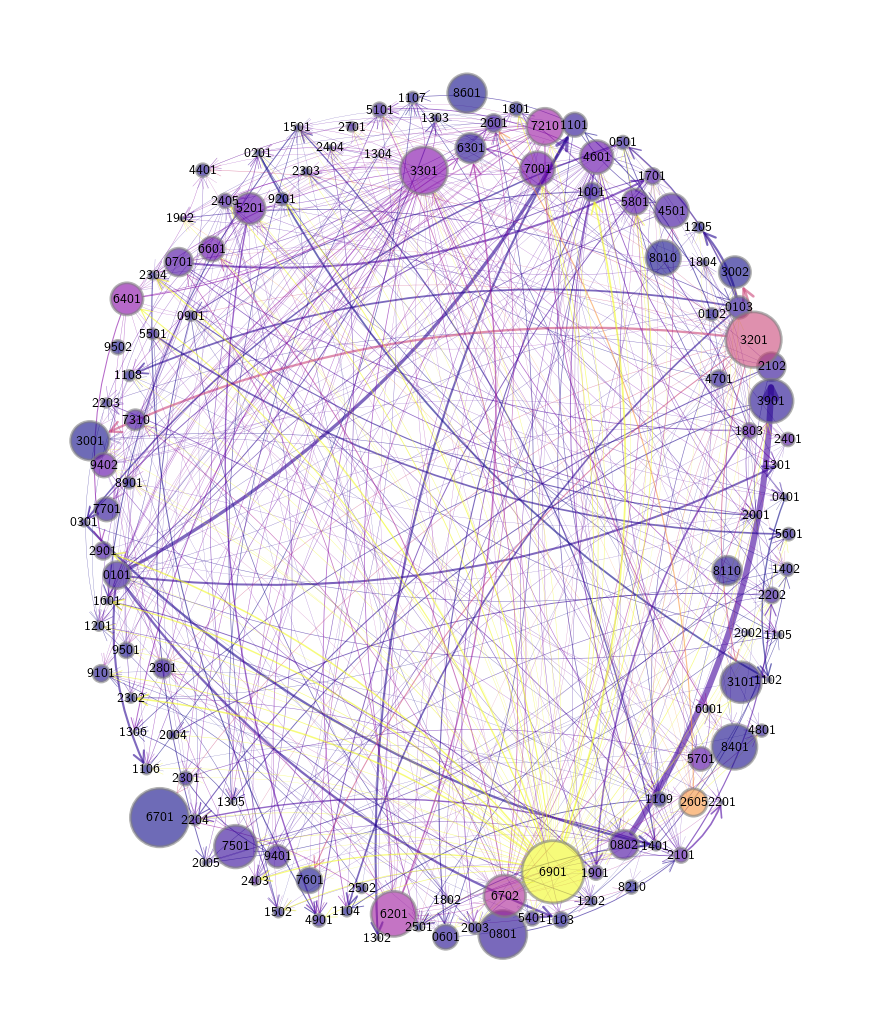
GDP growth rates and std. deviations (in parentheses) for 8 countries#
Here we load a pandas DataFrame of GDP growth rates.
gdp_df = ch2_data['gdp_df']
gdp_df.head()
| country | Brazil | United States | United Kingdom | France | Japan | Indonesia | Argentina | Mexico | Australia | South Africa |
|---|---|---|---|---|---|---|---|---|---|---|
| year | ||||||||||
| 1961 | 8.6 | 2.3 | 2.677119 | 4.980112 | 12.043536 | 5.740646 | 5.427843 | 5.000000 | 2.482618 | 3.844734 |
| 1962 | 6.6 | 6.1 | 1.102910 | 6.843470 | 8.908973 | 1.841978 | -0.852022 | 4.664415 | 1.294258 | 6.177931 |
| 1963 | 0.6 | 4.4 | 4.874384 | 6.233680 | 8.473642 | -2.237030 | -5.308197 | 8.106887 | 6.216364 | 7.373709 |
| 1964 | 3.4 | 5.8 | 5.533659 | 6.652100 | 11.676708 | 3.529698 | 10.130298 | 11.905481 | 6.980438 | 7.939609 |
| 1965 | 2.4 | 6.4 | 2.142177 | 4.861508 | 5.819708 | 1.081589 | 10.569433 | 7.100000 | 5.980351 | 6.122798 |
Now we plot the growth rates and calculate their standard deviations.
fig, axes = plt.subplots(5, 2, figsize=(8, 9))
axes = axes.flatten()
countries = gdp_df.columns
t = np.asarray(gdp_df.index.astype(float))
series = [np.asarray(gdp_df[country].astype(float)) for country in countries]
for ax, country, gdp_data in zip(axes, countries, series):
ax.plot(t, gdp_data)
ax.set_title(f'{country} (${gdp_data.std():1.2f}$\%)' )
ax.set_ylabel('\%')
ax.set_ylim((-12, 14))
plt.tight_layout()
if export_figures:
plt.savefig("figures/gdp_growth.pdf")
plt.show()
